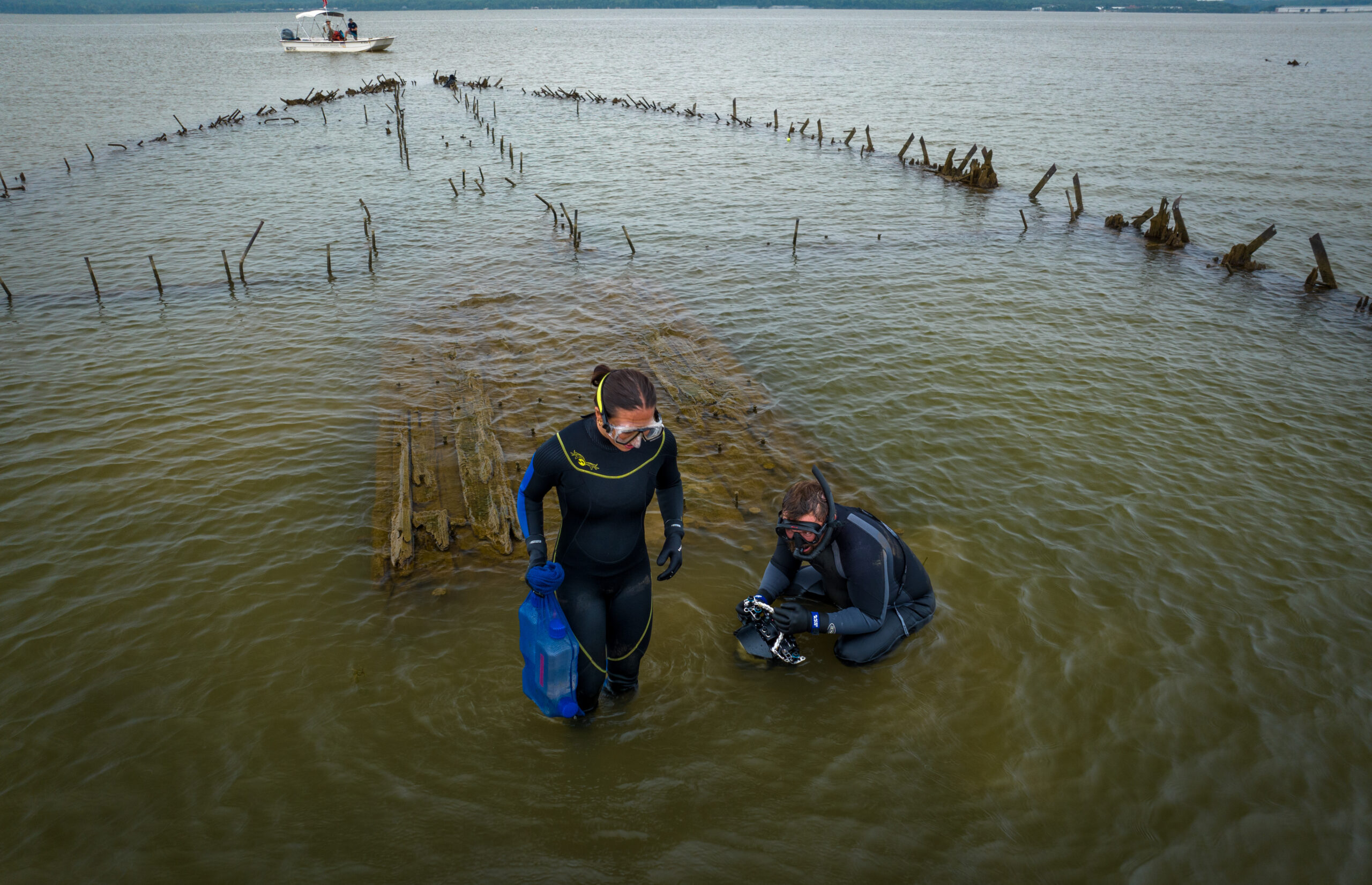
Coastal Careers: Underwater Archaeologist
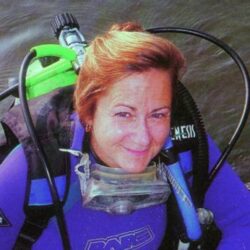
Written by: Susan Langley, Maryland State Underwater Archaeologist for the Maryland Historical Trust and member of the Sanctuary Advisory Council for the Mallows Bay-Potomac River National Marine Sanctuary
How is your work connected to national marine sanctuaries?
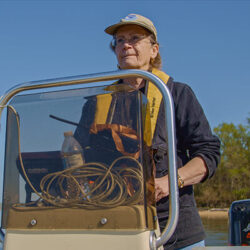
Photo credit: David J Ruck/NOAA
Like all mariners in American waters, we rely on NOAA’s navigational charts, but we also receive notices from NOAA’s Office of Coast Survey regarding what they have recorded while they were charting Maryland waters. In addition, I had the good fortune to have served on the Sanctuary Advisory Council for Monitor National Marine Sanctuary for ten years in various roles from the Archaeological Research Seat to Chair. This opportunity afforded the experience that was advantageous when Mallows Bay – Potomac River National Marine Sanctuary was proposed. The Maryland Historical Trust (MHT), in its capacity as the State Historic Preservation Office, under the Maryland Department of Planning, was a partner in the efforts to establish Mallows Bay as a sanctuary. MHT, with the Maryland Department of Natural Resources, and Charles County are the co-managers with NOAA of Mallows Bay-Potomac River National Marine Sanctuary, which at the time of its designation, was the first new national marine sanctuary in nearly 20 years.
What/who inspired you to pursue a career in underwater archaeology and historical preservation?
My parents were always history-oriented, and an uncle and aunt, who learned their home was on a site, hosted archaeology field schools. When I was bartending one summer, a fellow employee volunteered with the Coast Guard Auxiliary who convinced me to learn to scuba dive. My undergraduate field school was held at a fort on the Great Lakes operated by Parks Canada and when I asked if any underwater research had been carried out in the area, as it had seen a lot of action historically, I learned that Parks Canada had an underwater archaeologically program and had recently excavated the King’s Navy Yard nearby. This indirectly led to my being hired as a diver on the Red Bay excavations in Labrador. I later had the good fortune to work with the Thai underwater archaeology program on behalf of the Canadian International Development Agency (CIDA) for several years.
My sister is the family genealogist and discovered that our great-grandfather and his brothers were boat builders in Nova Scotia who died in a hurricane, so perhaps there is saltwater in my blood. If I had an “Aha!” moment it would be when, in retrospect, I realized a subliminal influence was a National Geographic photograph from January 1959 of a diver rising from a cenote, invisible in silt swirling from a ceramic vessel except for the hands holding it; it’s really stayed with me.
What kind of archaeology/preservation work happens in Mallows Bay-Potomac River National Marine Sanctuary (or what work would you like to see happen in the future)?
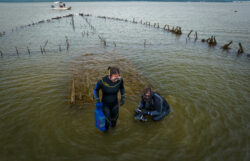
Photo credit: Matt McIntosh
Prior to its designation as a sanctuary, surveys and other studies done at Mallows Bay were largely opportunistic. Sanctuary status has permitted more directed and systematic research. Sanctuary Management Plans operate on a five-year cycle, and each requires a prior Condition Report that permits overall assessments of a number of variables and whether these are improving, stable, or deteriorating. Through diverse partnerships, particularly with East Carolina University, two Master’s theses have been completed and another is beginning, and two Doctoral dissertations are in progress. These have involved studies of microbiomes on both wooden and metal-hulled vessels, as well as studies of specific ships and vessel types.
I’m very excited to see all the research unfolding at Mallows Bay. Personally, I would like to see the outermost line of vessels protected as they take the brunt of storm action and once they deteriorate the next tier of ships is at risk. However, the nature of such protection would require extensive research since nothing happens in a vacuum and anything affecting one aspect of the Sanctuary will affect others.
What stories can shipwrecks like these tell us about our state and national maritime heritage? Why is it important to preserve and protect these shipwrecks and share these stories?
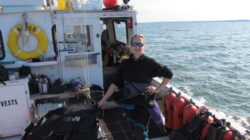
Photo credit: Susan Langley
The study of shipwrecks can provide information about the development of shipbuilding technology through time and in different countries and cultures. It can demonstrate trade patterns and the economic effects of these between nations or within a single country and its colonies. Cargoes, ordinance, human remains, and vessel structure can indicate where the ship and crew originated, where it travelled, who owned it or its cargo, and provide an historical snapshot or time capsule about a society and economy.
In the case of the U.S. Shipping Board Emergency Fleet Corporation vessels (USSB-EFC) in Mallows Bay, the original decision to construct 1000 non-navy steamships to carry supplies to the European theater of war, during World War I, required the assembly of sufficient personnel all trained to the same standards to operate the fleet. This resulted in the formalization of the American Merchant Marine. Although far fewer of the vessels were ultimately built, the establishment of shipyards throughout the country resulted in providing the infrastructure that pushed the U.S. to the forefront of ship construction in the 20th century. The Mallows Bay “Ghost Fleet” remains the largest homogeneous historic fleet in the world.
In addition to the World War I-era fleet, other watercraft have accumulated in the area; rather like the litter mentality that no one will notice another piece of litter if there is already some present. These are being researched individually and in groups but there is also the possibility of thematic studies, such as fisheries, transportation (ferries and steamboat landings), and other historic periods (Revolutionary, Civil and World War II eras).
It’s not always physically or economically viable to preserve shipwrecks, so it is critical to have these resources thoroughly documented. This permits ongoing study through time and by scholars who may not be able to physically access the sites.
What advice do you have for aspiring archaeologists?
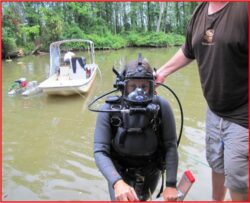
Photo credit: Susan Langley
Aspiring maritime archaeologists should seek a solid foundation in anthropology and terrestrial archaeology at the undergraduate level; in fact, that’s usually the only option with maritime studies usually only becoming a possibility at the graduate level. However, some undergraduate courses are available and should the opportunity present itself, it should be seized.
In addition, two skills that substantially increase one’s marketability are: being versed in GIS and electronic remote sensing. Also, being a scuba diver at the Divemaster level, at least, is desirable, but expertise and skills in troubleshooting and data analyses in remote sensing could mitigate if one cannot physically dive.
Take advantage of mentoring; formally or informally. The Advisory Council on Underwater Archaeology offers both virtual and in-person mentoring opportunities at every Society for Historical Archaeology Conference, held annually in January. Most government programs, such as State Historic Preservation Offices, and federal and local governments have educational outreach mandates. Some historic sites that receive government funding are also required to offer community outreach. Some of these are through formal events, symposia, or courses, but most professionals are also delighted to offer advice and guidance. Colleges and universities may be more limited to paying students, but some also have community outreach obligations as well; beyond Continuing Education programs. Volunteer and internship opportunities can be helpful, and many have realized they need to offer a stipend for students who can’t afford to work for free. Cultural Resource Management firms may be willing to offer advice and guidance but are less likely to use volunteers due to liability concerns and, also, their need to watch their bottom line and work as quickly as possible. Another way to become involved is through non-profit organizations with maritime archaeological interests. This is a segue to the next question.
What are some citizen science opportunities to get involved in historical preservation and archaeology and protecting our maritime heritage?
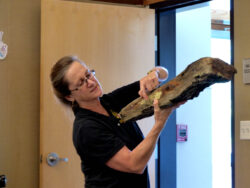
Photo credit: Susan Langley
Most states have at least one archaeological society, some are more active than others and some have maritime chapters as well; Maryland has the Archaeological Society of Maryland and, in Virginia, there is the Archaeological Society of Virginia and its Maritime Heritage Chapter. In the Chesapeake region, there is the Maritime Archaeological and Historical Society (MAHS), which offers a virtual Introduction to Underwater Archaeology course annually, the Institute of Maritime History (IMH), and the Battle of the Atlantic Research and Expedition Group (BAREG). Maryland is part of the multi-state Shipwreck Tagging Archaeological Management Program (STAMP) that involves tagging coastal shipwreck timbers with QR codes to track their movement (no diving necessary). A number of states are part of the Heritage Monitoring Scout program based in Florida, some of the members of the national Riverkeeper Network have archaeological interests but this varies, and it’s worth looking at the National Conference of State Historic Preservation Officers (NCSHPO) website to find the relevant office for a given state. Only nine states have dedicated maritime programs (FL, MA, MD, MI, NC, SC, TX, VA, WI) and many are not housed in the State Historic Preservation Office proper, and some states rely, unofficially, on non-profit organizations or university programs, and the SHPO should be able to direct anyone interested to an appropriate body offering citizen science opportunities.
What is your favorite memory at a national marine sanctuary or in the ocean?
I consider myself privileged to have had the opportunity to visit and dive at both Bikini Atoll (a.k.a Eschscholtz Atoll) and Chuuk (Truk) Lagoon. These are amazing in different ways but are both historically important and environmentally stunning. I have not yet been able to visit many of the National Marine Sanctuaries. Channel Islands and Monterey Bay National Marine Sanctuaries are two I visited some time ago and Thunder Bay National Marine Sanctuary is upcoming, but I have plans to see how many I can visit in the future.
